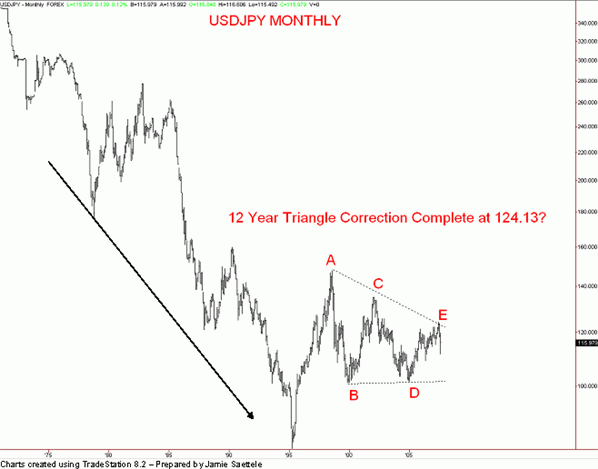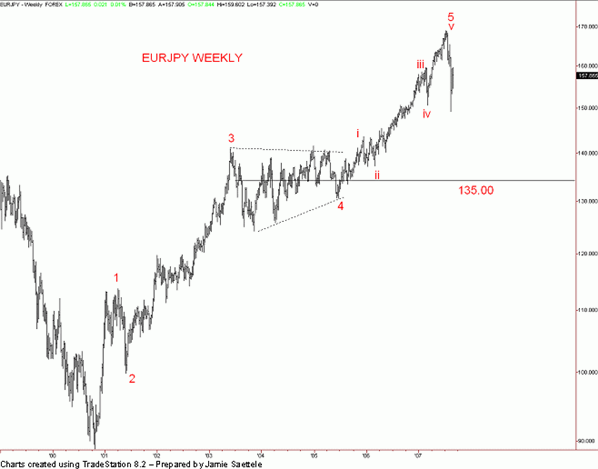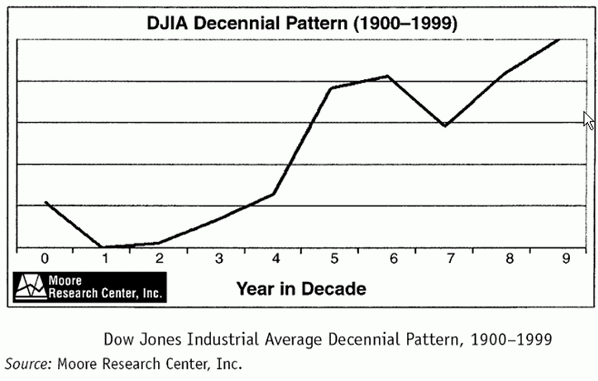|
Yen: the Best Trade for the End of the Year
For those traders forecasting a significant slowdown in US economy in 2008 we take a look at the merits and dangers of selling USD/JPY from both a fundamental and technical perspective. The stock market is entering its worst period historically within the monthly, seasonal and 10-year cyclical patterns. Given the high correlation between stocks and the JPY crosses, the biggest decline in years may be in store for the JPY crosses over the next few months.
Show Me the Money
Speculators and investors may disagree about the extent of the damage from the recent fallout in the sub-prime markets but one fact is incontrovertibly clear – credit is no longer cheap or easily available. Although long-term jumbo mortgage rates have come off their highs they are still more than 100 basis points higher than the traditional 30-year fixed mortgage. Furthermore, not only has credit become expensive, but lending standards have been tightened considerably over the past month. Poor credit ratings and no-income verification loans are quickly becoming history. Potential house buyers will now require a strong personal balance sheet and will have to adhere to more stringent lending terms.
This change in the real estate markets will inevitably lead to lower home sale prices and less mortgage equity withdrawal activity in the next year. Already existing home sales have declined to 5.70 Million annual rate down from the peak of 7,21 Million units less than two years ago while new homes sales are averaging 870K units from their peak of 1389K. Although residential real estate directly accounts for only 5% of the GDP, some analysts calculate that the indirect impact of the real estate market on the US economy, when finance and retail sectors are factored in, may be responsible for as much as 50% of GDP growth over the past several years.
In short, the contraction in real estate market should lead to a deceleration in the overall economy, but because this process is gradual, its effects may not be fully realized until 2008. Indeed given the blazing 4% GDP growth recorded in the 2nd quarter of 2007, it’s hard to believe that a US recession is possible in the near future. Yet the GDP numbers represent economic activity before the recent market turbulence. Going forward, US demand is likely to slow significantly as the weight of the new reality in the credit markets begins to bear down on the US consumer facing more than 1 Trillion dollars of Adjustable Rate Mortgages in the next year. The average combined loan-to-value ratios of these 2004-2006 vintage loans are approximately 92%, allowing for very little margin of error. Therefore, this combination of massive increases in mortgage costs in conjunction with much tighter credit standards is likely to result in a new wave of bankruptcies and is the primary reason to expect an economic slowdown in 2008. Evidence of deceleration in growth is already building in the employment numbers. June’s Non Farm payrolls report printed below the key 100K job level for the first time since February and latest weekly numbers jobless claims numbers ballooned to 334K – highest level in 5 months.
The Carry Unwind
If the forecast for a slowdown in the US economy is indeed correct, what trade in the currency market would benefit most from such outcome? For those traders betting on this scenario we believe a short USD/JPY position may offer the most promising opportunity in 2008. Over the past two years USD/JPY has been essentially a one way trade to the upside as the pair benefited from the widening interest rate differentials between the dollar and the yen as well as increased risk appetite as global equity markets soared across the board. A sharp deceleration in US growth will reverse both of those dynamics making the carry trade far less attractive and setting in motion the long unwind process.
On the interest rate front, market participants expect the Fed to begin easing in response to the turbulence of the past several weeks. Although it appears as though FOMC members are reluctant to cut rates, if labor data continues to deteriorate the Fed will have no choice but to act. As the loosening cycle builds force the rate differentials between the dollar and the yen will begin to compress and may even accelerate if the BOJ continues its normalization process as Asian economies appear to be relatively insulated from the liquidity crunch affecting western markets.
More importantly, however, the slowdown in US economy is sure to impact the profit margins of US corporations and will likely cause a decline in the Dow. Over the past two years the carry trade benefited tremendously from the rise in equities as risk tolerance increased significantly. In fact USD/JPY has a greater than 0.6 correlation with Dow Jones index suggesting that the carry trade has been driven as much by the stock market rally as by the interest rate spread between the yen and the dollar. As equities rallied many speculators finances their US stock purchases with very cheap yen loans levering up their positions. That is why any downdraft in stocks immediately brings a decline in the USD/JPY pair as those positions are unwound. Should the US stock market enter a prolonged bear phase, USD/JPY is quite likely to follow as stop losses and margin calls will trigger a sharp decline in the pair.
Risks to the Trade
There are of course critical risks to this trade. First and foremost, the US economy may weather the collapse of housing and remain resilient as exports, most notably in the technology sector, helped by the lower dollar, pick up the slack in demand. Secondly, Japanese retail investors, who continue to be the biggest proponents of the carry trade, as they seek yield for their large pool of domestic savings could provide a very strong bid for the carry trade irrespective of cuts by the Federal reserve. The latter scenario could be especially likely if the Fed’s policy initiate is slow and gradual, resulting in only modest compression of yields. Finally, a short USD/JPY incurs significant interest rates costs for investors, and those contemplating a long-term position should most particularly be mindful of the leverage of the position which could magnify those costs many fold. Nevertheless, those traders who are confident in their prognosis of a slowdown in US economy in 2008 may want to express that idea through the short USD/JPY position which should benefit disproportionately from any decline in US interest rates and equity prices.
Technical Picture

The USD/JPY may have completed a 12-year correction in the form of a triangle at 124.13. Triangles unfold in 5 waves (A-B-C-D-E) and the structure above is clearly in 5 waves. There is risk of wave E extending higher towards the next major resistance level of 128.00 but the weight of evidence suggests that wave is complete at 124.13. For one, wave E is close to 61.8% of wave C. Alternating legs of triangles are often related by 61.8% or a derivation of Φ (Phi….618). Wave E would be exactly 61.8% of wave C at 122.57. The top was at 124.13. A difference of just 155 pips when projecting a move that is nearly 3000 pips works out to just over a 5% error. The time relationships between the different legs of the triangles also favor the idea that wave E is complete at 124.13. The weeks that each leg of the triangle took to unfold (from A to E) were 41, 16, 27, 37, 30. The average length of time for each leg is 30.2. Wave E took 30 weeks. The 'look' is right for a top and reversal of significant proportion. A terminal thrust in the direction of the larger trend succeeds completion of a triangle. In the case of the USD/JPY, a terminal thrust would result in a drop below the 1995 low of 81.12. A break of the base of the triangle at 101.26 would strongly signal that price is headed below 81.12. However, with the evidence making a strong case that the triangle is complete at 124.13, a bearish bias is warranted at the current juncture against 124.13.

The EUR/JPY structure is in line with the idea that a significant top is in place at 124.13 in the USD/JPY. The rally from the October 2000 low (88.94) appears to have completed 5 waves. The 5th wave, which began at 130.60, was the result of a thrust from the wave 4 triangle. As mentioned, triangles lead to terminal moves so expectations are for a return to at least the center of the triangle near 135.00 in the next few months.

The DJIA and JPY crosses have tracked each other for the better part of this decade. With this in mind, analysis of the DJIA can support or refute our bearish bias on the JPY crosses. Over the last 100+ years, stocks have exhibited what is termed the decennial pattern. In the pattern, years 0-2 of the decade are bearish for stocks as is year 7. Specific examples include the Panic of 1907 when the stock market crashed in both March and October. The DJIA ended 1907 down 38%. 1917 saw a 23% drop in the DJIA. 1927 was a positive year for stocks but the DJIA dropped 5.2% in the September-October period. In 1937, stocks began plummeting in March and ended the year down 32%. The biggest declines of that year came in September and October when Stocks fell 20%. 1947 was flat (up 3% for the year). Stocks declined 12% in 1957 and 9.3% of that decline occurred in the September-October period. 1967 was a positive year but stocks declined 8.7% in the September-October period. A drop of 17% occurred in 1977 with 5.4% of the decline occurring in the September-October months. The DJIA ended up 1% in 1987 but October 19th was Black Monday, the second largest one-day percentage decline in stock market history. Equities rallied strongly in 1997, finishing the year up 22%. However, the September-October months were bearish (down 3%). In summary, history tells us that the September-October months are seasonally bearish and years ending in 7 are cyclically bearish. The confluence of these two patterns have led to the worst stock market crashes in history. Given the high correlation between stocks and the JPY crosses, the biggest decline in years may be in store for the JPY crosses over the next two months. Recent technical articles on the JPY/Dow relationship can be found at early August and June.
Boris Schlossberg is a Senior Currency Strategist at FXCM.
|